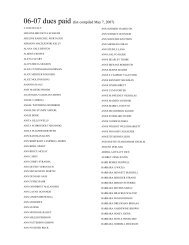Teresan News Summer 2012 - Alumnae Association of the College ...
Teresan News Summer 2012 - Alumnae Association of the College ...
Teresan News Summer 2012 - Alumnae Association of the College ...
You also want an ePaper? Increase the reach of your titles
YUMPU automatically turns print PDFs into web optimized ePapers that Google loves.
Finding familiar faces 3,000 miles away from home<br />
By Jerome Christenson<br />
I thought it was my first trip into <strong>the</strong> Third World.<br />
It wasn’t a neighborhood featured in <strong>the</strong> tourist guides. Sister Margaret Kiefer OSF ’46 - we just<br />
called her Marg - was taking us to visit her friend, a young man she visited every week and who she<br />
was certain we wanted to meet. His name is Luis. He’s 29, lives with his mo<strong>the</strong>r, and according to<br />
Marg, dreams <strong>of</strong> someday becoming a lawyer.<br />
The street in front <strong>of</strong> <strong>the</strong>ir home, carved into <strong>the</strong> Andean mountainside, <strong>of</strong>fers spectacular glimpses <strong>of</strong><br />
Bogotá and <strong>the</strong> surrounding mountains. “A million-dollar view,” Marg calls it.<br />
We hadn’t been 24 hours in Colombia when we climbed into <strong>the</strong> white school van and nosed out into<br />
<strong>the</strong> traffic-jammed streets <strong>of</strong> <strong>the</strong> capital city, past shopping malls, Subaru dealerships, high-rise apartment<br />
blocks and into <strong>the</strong> pages <strong>of</strong> National Geographic.<br />
The gouges and potholes grew in depth and number as <strong>the</strong> narrowing street switchbacked across <strong>the</strong><br />
face <strong>of</strong> <strong>the</strong> mountain, past an endless jumble <strong>of</strong> tiny eateries, second-hand shops, mechanics, metal<br />
workers, grocers and bars. Homes and commercial buildings rose flush to <strong>the</strong> narrow sidewalk or, <strong>of</strong>ten,<br />
to <strong>the</strong> very edge <strong>of</strong> <strong>the</strong> street - <strong>the</strong> steeply rising mountainside itself <strong>of</strong>ten providing a solid, if windowless,<br />
back wall.<br />
Luis’ home is built like that. Driving past, Marg pointed to it, but our eyes saw only a dirty plastic tarp<br />
and some sheets <strong>of</strong> corrugated ro<strong>of</strong>ing wedged into <strong>the</strong> muddy mountainside. We pulled up, and only<br />
<strong>the</strong>n saw <strong>the</strong> unpainted door hung askew in a scrap lumber frame.<br />
Marg knocked, and Luis’ mo<strong>the</strong>r greeted us graciously in Spanish and escorted us along <strong>the</strong> short,<br />
steep, dirt-floored hallway, past <strong>the</strong> rust-red chicken te<strong>the</strong>red by its right leg to a table overloaded with<br />
bags and cartons <strong>of</strong> <strong>the</strong> discards and scraps she ga<strong>the</strong>red to sell and recycle.<br />
Luis smiled broadly, looking up from his pillow. A strapping 6-footer, he had been confined to his bed<br />
since <strong>the</strong> day years ago he came to Bogotá on a visit from his home in <strong>the</strong> countryside and a stray bullet,<br />
fired by someone for some reason no one knows, tore into his spine, leaving his body useless much<br />
below his shoulders.<br />
Still, every day he studies. Marg and his tutor bring him schoolbooks. Turning <strong>the</strong> pages with painfully<br />
crippled arms, his fists permanently and involuntarily clenched, he fights for <strong>the</strong> education he hopes,<br />
believes <strong>of</strong>fers him a future beyond <strong>the</strong> mountainside.<br />
Our visit was short. We had places to go, people to see. Luis had to study and his mo<strong>the</strong>r had much to<br />
do, as she does every day. The van jostled us down <strong>the</strong> mountainside, dodging buses and dump trucks<br />
with inches to spare, passing mo<strong>the</strong>rs and children, old men and young, dogs trotting alongside, sniffing<br />
for tidbits in <strong>the</strong> mud.<br />
That evening we crossed <strong>the</strong> street from our guest house to pick up some snacks and sundries at <strong>the</strong><br />
neighborhood shopping mall — three stories <strong>of</strong> American-style merchandising, Budweiser and pretzels<br />
priced in Colombian pesos. It felt so much like home.<br />
And for some reason I thought <strong>of</strong> a man I’d driven past back home just days before. He was standing by<br />
<strong>the</strong> highway, holding a hand-lettered sign fashioned from <strong>the</strong> side panel <strong>of</strong> a corrugated cardboard box.<br />
Our eyes met for a moment, before I motored across <strong>the</strong> intersection and out <strong>of</strong> his life, leaving him<br />
<strong>the</strong>re with his bedroll and sign that read, “Homeless. Please help.”<br />
Of course that mall in Bogotá felt like home. I’d traveled 3,000 miles to see faces, hear voices I manage<br />
to look past nearly every day.<br />
The Third World, it seems, is where you find it. We only have to look.<br />
46



